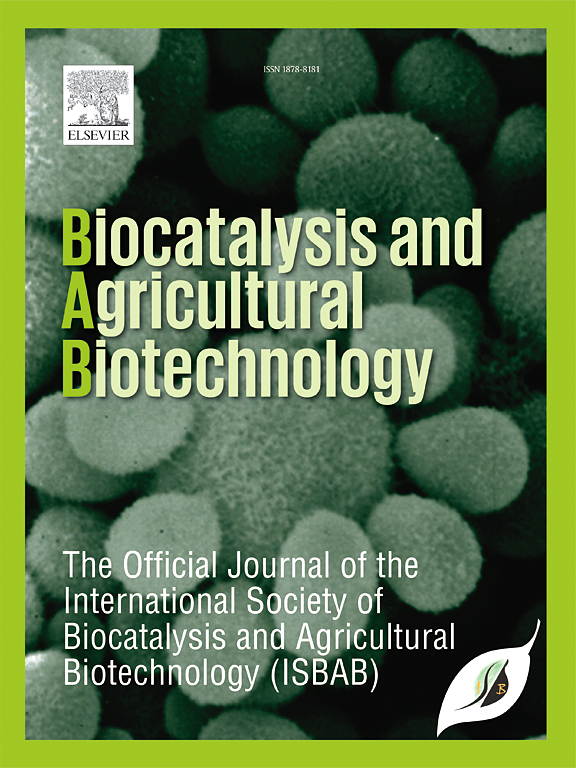利用响应面方法优化虾壳和蟹壳作为生物絮凝剂用于小球藻收获的效果
IF 3.8
Q2 BIOTECHNOLOGY & APPLIED MICROBIOLOGY
引用次数: 0
摘要
在絮凝过程中使用生物絮凝剂为分离固相和液相提供了一种可行的方法,尤其适用于微藻收获。生物絮凝剂的剂量、pH 值和阳离子诱导剂的剂量等关键参数会对微藻收获的成功与否产生重大影响。本研究旨在考察从虾壳和蟹壳中提取的壳聚糖作为生物絮凝剂在微藻类(特别是焦绿小球藻)收获过程中的功效。本研究采用了中央综合设计(CCD)和响应面方法(RSM)来获得最佳絮凝条件,其特点是絮凝效率高、沉降时间短。在生物絮凝剂为 0.499 克/升、pH 值为 9.09、阳离子诱导剂为 0.172 克/升的条件下,从虾壳中提取的壳聚糖达到了最佳收获条件,絮凝效率为 92.58%,沉淀时间为 133.49 秒。同时,在生物絮凝剂 0.434 克/升、pH 值 8.96 和阳离子诱导剂 0.168 克/升的条件下,从蟹壳中提取的壳聚糖达到了最佳收获条件。基于这一事实,虾壳和蟹壳作为生物絮凝剂用于收获绿藻的潜力是显而易见的。此外,絮凝效果和沉降时间还受到阳离子诱导剂浓度、生物絮凝剂水平和 pH 值等变量的显著影响。本文章由计算机程序翻译,如有差异,请以英文原文为准。
Optimization of shrimp and crab shell as bio-flocculant for Chlorella pyrenoidosa harvesting using response surface methodology
The use of bio-flocculants in flocculation processes offers a feasible approach for separating solid and liquid phases, with a particular focus on microalgae harvesting. Critical parameters such as the dose of bio-flocculant, pH level, and dose of cationic inducer significantly impact the success of microalgae harvesting. This study aims to examine the efficacy of chitosan derived from shrimp shells and crab shells as bio-flocculants in microalgae harvesting, specifically Chlorella pyrenoidosa. Central Composite Design (CCD) and Response Surface Methodology (RSM) were employed in this study to attain optimal flocculation conditions, characterized by high flocculation efficiency and short settling time. The optimal harvesting condition using chitosan derived from shrimp shells was achieved at 0.499 g/L of bio-flocculant, pH 9.09, and 0.172 g/L of cationic inducer with 92.58% efficiency and 133.49 s settling time. Meanwhile, The optimal harvesting condition with chitosan derived from crab shells was achieved at 0.434 g/L of bio-flocculant, pH 8.96, and 0.168 g/L of cationic inducer. This resulted in an efficiency of 93.72% and a settling time of 117 s. Based on this fact, the potential of shrimp shells and crab shells as bio-flocculants for Chlorella pyrenoidosa harvesting is evident. Furthermore, the efficacy of flocculation and settling time are significantly influenced by variables such as the concentration of cationic inducers, the levels of bio-flocculants, and pH.
求助全文
通过发布文献求助,成功后即可免费获取论文全文。
去求助
来源期刊

Biocatalysis and agricultural biotechnology
Agricultural and Biological Sciences-Agronomy and Crop Science
CiteScore
7.70
自引率
2.50%
发文量
308
审稿时长
48 days
期刊介绍:
Biocatalysis and Agricultural Biotechnology is the official journal of the International Society of Biocatalysis and Agricultural Biotechnology (ISBAB). The journal publishes high quality articles especially in the science and technology of biocatalysis, bioprocesses, agricultural biotechnology, biomedical biotechnology, and, if appropriate, from other related areas of biotechnology. The journal will publish peer-reviewed basic and applied research papers, authoritative reviews, and feature articles. The scope of the journal encompasses the research, industrial, and commercial aspects of biotechnology, including the areas of: biocatalysis; bioprocesses; food and agriculture; genetic engineering; molecular biology; healthcare and pharmaceuticals; biofuels; genomics; nanotechnology; environment and biodiversity; and bioremediation.
 求助内容:
求助内容: 应助结果提醒方式:
应助结果提醒方式:


